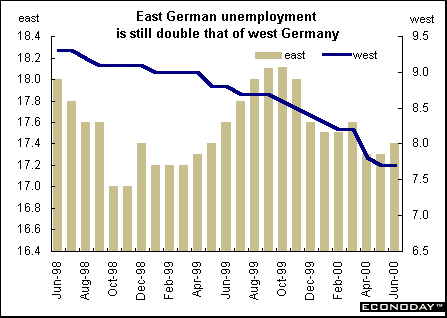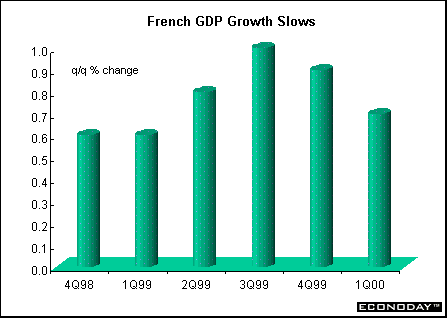| Previous Articles |
|
What
should investors believe? The tankan survey had both good and bad news, which left the markets pretty much where they were before - wondering if the Bank of Japan will finally kick the zero interest rate habit and raise rates at their July 17 meeting. Larger enterprises finally emerged with positive sentiment readings while small businesses remained mired in negative numbers. (See Indicator Scoreboard below for details.)
Britain and Europe The economic news was market friendly. And although the indexes bounced around a bit, they ended the week with resounding gains. Inter-day volatility has diminished significantly recently. On the week, the London FTSE 100 climbed 182.7 points or 2.89 percent to end at 6495.40. The Paris CAC closed the week at 6565.97, up 119.43 points or 1.85 percent, while the Frankfurt DAX rose 154.01 points or 2.23 percent to end at 7052.22.
Asia
The Bank of Japan's quarterly tankan index of large manufacturers' sentiment rose to plus 3 in June from minus 9 in March, marking the first time since September 1997 that the index emerged in positive territory! This means that more large manufacturers are optimistic about the economy than pessimistic. Yet this was not the case for small manufacturers who are still struggling and continue to be pessimistic. Foreign investors were net sellers of Japanese stocks in June on the Tokyo, Osaka and Nagoya stock markets. This is the third straight month in a row that foreign investors have been net sellers of Japanese stocks. Excluding the thin trading week of May 1, foreign investors had been net sellers for 13 weeks since the week of March 13. Foreigners accounted for Y1.289 trillion of sales against Y1.213 trillion of purchases. In other Asian markets, the Singapore Straits Times Index rose to 2101.23, its highest level in more than eight weeks. Hong Kong's Hang Seng Index rose 354.72 to 16,859.31, its highest since April 12. Americas
The Toronto Stock Exchange Composite 300 continued its record setting ways, ending the week at another new high of 10,380.3. Although the TSE's increase last week pales when compared with the Bolsa, its climb has been more sustained. The TSE gained 184.85 points or 1.81 percent. Although the TSE is influenced heavily by the U.S. economy's performance and of the Dow and Nasdaq as well, Canadian economic performance continues to bolster investors. The U.S. Dow and Nasdaq were both up. The Dow ended the week up 1.8 percent or 188.09 points to close at 10635.98 while the Nasdaq climbed above 4,000 again and ended at 4023.20, up 57.09 points or 1.44 percent. Neither the Dow nor the Nasdaq is above its yearend close. Currencies
Even with U.S. rates on hold, the EMU's interest rate differential with the United States remains intact, damping demand for the euro. Returns on three-month euro-denominated deposits lag those in dollars by 2.21 percentage points. The many favorable economic reports that show an improving economy have failed to boost investor's perceptions of EMU growth. As a result, analysts think that the euro will continue to tread water against the dollar. The yen fell to a one month low against the dollar, bringing its losses for the past two weeks to 2.8 percent. Expectations remain that Japanese interest rates won't rise soon. Traders also hesitated to buy yen because of speculation that the Group of Seven finance ministers, which met over the weekend, would continue to urge Japan to keep interest rates low in order to spur economic growth.
The Bank of Japan lowered its benchmark lending rate to near zero in March 1999 as an emergency measure to help the economy recover from recession. That also cut returns on short term yen deposits, which now lag those in dollars by 6.5 percentage points. In recent months, BoJ governor Masaru Hayami has called the policy abnormal and repeatedly has suggested that rates will rise as soon as consumer demand picks up and deflation is no longer a threat. The prospect of higher Japanese rates has not been popular with the other Group of Seven members (United States, Germany, United Kingdom, France, Italy and Canada). They are looking for a rebound that will revive Japanese consumers' demand for foreign goods. At past G-7 meetings, Japan has pledged to keep interest rates near zero to help rescue the economy out of its decade long slump. Lackluster economic reports this week damped expectations that a move toward higher rates would come as soon as the bank's July 17 meeting. May household spending declined and the mixed results from the tankan survey of business confidence prompted concern the nation's recovery is still fragile. There is now the possibility that there may be interest rate divergence -- not convergence -- between Japan and its trading partners. Indicator
scoreboard April real retail sales rose 1.5 percent on the month and 4.1 percent on the year. The late Easter holiday shifted much of the holiday related sales into April this year. In 1999, Easter fell on the first weekend of April, boosting late March retail activity. April real retail sales rose mainly due to increased spending on textiles, clothing and footwear, which were up 1.7 percent on the month. Spending on household goods rose 1.5 percent, while spending on food, drinks and tobacco rose 1.0 percent from March. While monthly data are adjusted for inflation, seasonal factors, and the number of working days, annual data are adjusted only for inflation and working days.
The European Commission's economic sentiment index for the EMU was steady in June for the fourth consecutive month, as a decline in consumer confidence offset gains in all other areas. Consumer confidence, although at a historically high level, unexpectedly dropped as consumers' general economic outlook and price outlook over the next 12 months deteriorated. Industrial confidence rose to a record high with the production outlook and order book levels continuing to rise. Industrial confidence in Italy, Germany and France posted the largest gains.
May seasonally adjusted unemployment rate was unchanged at 9.2 percent, the lowest since July 1992. Of the nine EMU states reporting data, the unemployment rate fell in five member states and remained unchanged in four.
June seasonally adjusted manufacturing activity based on data from six EMU countries slipped to 59.5 in June from 59.7 in May. The price index, which is not part of the overall index, eased in June to 72.7 from 76.7 in May. The output subindex rose to 62.1 after 61.8 in May. Strong demand was the main reason cited behind manufacturing expansion. The new orders index rose to 60.6 after 60.5. The European Monetary Union Purchasing Managers' Index is based on results from Germany, France, Italy, Spain, Ireland and Austria and is published by Reuters. Germany - June seasonally adjusted unemployment rate remained steady at 9.6 percent for the third month in a row. The rate in the west was steady at 7.7 percent, while that in the east rose to 17.4 percent from 17.3 percent. On an unadjusted basis, the west German unemployment rate fell to 7.4 percent from 7.5 percent while east German unemployment rate fell to 16.5 percent from 16.9 percent.
May pan-German manufacturing orders jumped 1.9 percent. Orders rose 2.2 percent in west Germany while they fell 4.3 percent in east Germany. The east German decline was due solely to a 19.3 percent orders drop in the volatile capital goods category. May pan-German industrial production soared 2.2 percent on the month and 6.7 percent on the year. May west German industrial production rose 2.2 percent on the month while east German industrial production rose 0.8 percent. Manufacturing - which accounts for the bulk of industrial production - was up 1.7 percent, led by a 2.3 percent gain in intermediate goods output and a 2.0 percent rise in capital goods production. France
Italy - May producer prices surged 0.9 percent on the month and were up 6.4 percent when compared with last year, as higher import prices for oil were compounded by a weak euro. The May jump was the highest since May 1995, while the 6.4 percent jump when compared with last year was the highest since December 1995. Britain - June Chartered Institute of Purchasing and Supply Purchasing Managers Index fell to 50.2 from 50.8 in May. The CIPS survey showed growing inflationary pressures in the manufacturing sector caused by a combination of supply shortages, higher oil prices and a fall in the value of the pound sterling. The price index jumped to 61.4 in June from 59.7 in May. The output index fell back to 50.5 in June from 50.9 the previous month, indicating that the pace of output growth slowed. The CIPS June services business activity index dropped to 57.2 from 58.5 in May. Expectations of future growth were significantly lower than a year earlier. Cost pressures accelerated to the highest rate since 1996, with the input price index edging up to 62.1 from 62.0 in May. Growth in prices charged eased slightly from the four year survey high recorded in May. The index fell to 54.0 in June from 54.7 the previous month. June seasonally adjusted Halifax house prices index fell 0.4 percent but was up 9.2 percent on the year. The annual rate returned to below 10 percent for the first time since September 1999, and is now well below January's 16.0 percent peak. Halifax said that the four interest rate increases between last September and February and the abolition of mortgage interest tax relief in April are two of the key factors behind the cooling in house price inflation.
Total seasonally adjusted housing starts in the three months to May fell 1 percent compared with the previous quarter and fell 1 percent on the year. Total completions in March to May rose 1 percent on the previous quarter and were unchanged on the year earlier. May manufacturing output rose 0.4 percent on the month and was up 1.8 percent on the year. Nearly half (0.18 percent) of the rise in manufacturing output could be attributed to a recovery in car production from April's very low figure. Asia
May overall real household spending was down 1.9 percent from the same period last year. The weak data - coming after a 1.3 percent on-year rise in April - suggest that consumer spending has failed to firmly catch on to the recovery spotted in the corporate sector of the economy. The propensity for wage earners to consume (a ratio which measures the amount of disposable income going to household spending) rose to 72.9 from 71.9 percent in April on a seasonally adjusted nominal basis. Americas
BOTTOM
LINE Economic reports key to the Bank of England's rate making process, including retail and producer price indexes and labor market data, will be released this week. Although the Bank of England has refrained from raising interest rates since February, investors will be eyeing average earnings data and the retail price index excluding mortgages in particular for inflationary signs.
|
|||||||||||||||||||||||||||||||||||||||||||||||||||||||||||||||||||||||||||||||||||||||||||||||||||||||||||||||||||||||||||||||||||||||||||||||||||||||||||||||||||||||||||||||||||||||||||||||||||||||||












